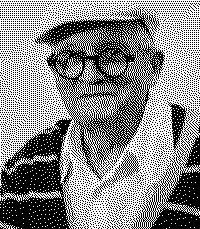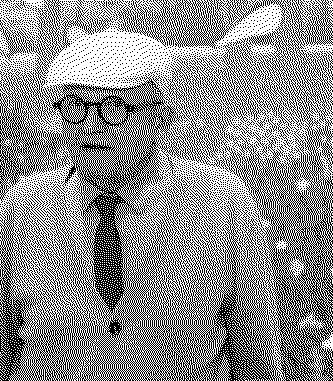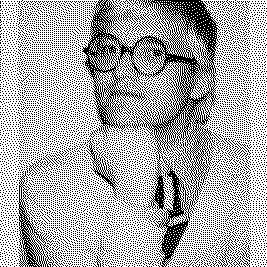Artists/David Hockney
Fast Facts
California Influence
A significant portion of Hockney's work was inspired by his time in California. His famous pool paintings, characterized by vivid blues and leisure themes, are a testament to this influence.
Diverse Mediums
He is versatile in his choice of mediums, working in painting, drawing, printmaking, photography, and even digital media like iPads.
Vibrant Color Palette
Hockney is renowned for his use of bright, vibrant colors. His paintings often feature bold and saturated hues, contributing to their lively and dynamic feel.
Photo Collages
In the 1980s, Hockney began creating "joiners," which were photo collages made from a patchwork of Polaroid snaps or photolab prints. These works played with perspective and time, offering a novel way of viewing a scene.
Exploration of Perspective
Throughout his career, Hockney has experimented with perspective. This includes playing with point of view and depth, challenging traditional methods of representing space and volume in art.
Portraits and Landscapes
His oeuvre includes a wide range of subjects, but he is particularly noted for his portraits and landscapes, each marked by his distinctive style and use of color.
Digital Art Pioneer
In his later years, Hockney embraced technology, particularly digital painting on iPads. He has produced a significant body of work on this digital platform, showcasing his adaptability and ongoing creativity.
Biography



David Hockney, born on July 9, 1937, in Bradford, Yorkshire, England, is a prominent English painter, draftsman, printmaker, photographer, and stage designer.
Hockney's work is distinguished by its economical technique, a focus on light, and a blend of mundane realism with elements drawn from Pop art and photography. His journey into the art world began with his studies at the Bradford College of Art from 1953 to 1957 and continued at the Royal College of Art in London between 1959 and 1962, where he won a gold medal in the graduate competition. His time in the United States, particularly from 1961 and more extensively between 1964 and 1967, marked a significant phase in his development and career (Encyclopedia Britannica).
Hockney's early life in Bradford set the stage for his illustrious career. The fourth of five children, Hockney was raised in a family where his father, a conscientious objector during the Second World War, and his mother, a devout Methodist and strict vegetarian, provided a stable yet ideologically rich background. His education spanned Wellington Primary School, Bradford Grammar School, Bradford College of Art, and the Royal College of Art in London. His early works, while associated with the Pop art movement, also showed expressionist elements reminiscent of Francis Bacon's paintings. Hockney's time at the Royal College of Art was marked by his refusal to complete a traditional life drawing for his final assignment, leading to a significant standoff with the college. The institution eventually conceded, allowing him to graduate based on his body of artwork, recognizing his talent and burgeoning reputation (Wikipedia).
Hockney's relocation to Los Angeles in 1964 became a pivotal moment in his career, inspiring him to create a series of paintings focusing on swimming pools, utilizing the vibrant colors of acrylic paints. His residences in Los Angeles, London, and Paris throughout the late 1960s and 1970s, and later his return to Yorkshire, often to visit his mother until her death in 1999, influenced his work significantly. During the 1990s and onwards, Hockney began capturing the Yorkshire countryside in his paintings, an endeavor that became more pronounced after 2003 when he started painting en plein air. His work has been characterized by an exploration of various mediums including painting, drawing, printmaking, photography, and digital technologies, covering a wide range of subjects from still lifes and landscapes to portraits and stage designs (Wikipedia).
Throughout his career, Hockney has been known for his portraits, which include intimate depictions of friends, lovers, and relatives. Notable among his works are the portraits and double portraits painted just under life-size in a realistic style, capturing the essence of his subjects. His exploration of portraiture has been a consistent theme, revisiting subjects such as his family, close associates, and himself through more than 300 self-portraits. Hockney's investigation into optical devices, such as the camera lucida, for both art historical research and practical application in his studio work, underscores his continual experimentation and innovation within his practice (Wikipedia).
David Hockney's life and work encapsulate the evolution of contemporary art through the lens of one of its most influential figures. His contributions to the art world, marked by his unique blend of realism, Pop art influences, and innovative use of technology, have solidified his position as a pivotal artist of the 20th and 21st centuries.
Bodies of Work
-

Love Paintings
1960–1963
-

Swimming Pools
1964–1971
-

Double Portraits
1968–1977
-

The Weather
1973
-

Opera Sets
-

Paper Pools
1978
-

Photo Collages / Joiners
1982–1986
-

Homemade Prints
-

Moving Focus
1984–1986
-

Fax Art
-

Very New Paintings
1992–1993
-

A Closer Grand Canyon
-

Midsummer: East Yorkshire
-

A Bigger Picture
-

iPad Drawings
-

Yosemite Suite
-

The Four Seasons
2010–2011
-

82 Portraits and 1 Still-Life
2013–2016
-

The Card Players
Importance
David Hockney's importance in the art world is vast and multifaceted, showcasing his unique contributions across different media and his deep engagement with the visual and experiential possibilities of art.
Revolutionizing Landscape and Portraiture
Hockney's work in landscapes and portraiture has been highly influential. His landscapes, inspired by both his English homeland and the vibrant hues of California, often combine traditional painting techniques with modern technology, such as digital photography and iPad drawings. His approach to portraiture, particularly his double portraits from the 1960s and 1970s, not only highlights his skill in realism but also his dialogue with art historical traditions, including Renaissance painting and the conventions of the stage (The Art Story) (Art and Object).
Innovative Use of Technology
Hockney has embraced technology not only as a tool but as a central aspect of his creative expression. From his early adoption of the Polaroid camera for his composite photos to his later work with digital cameras and iPad drawings, Hockney has explored how these tools can transform the way we see and depict the world. This innovative use of technology has made him a pioneer in merging traditional art forms with the digital age, reflecting on the nature of representation and perspective (The Art Story) (National Portrait Gallery).
Experimentation Across Media
Throughout his career, Hockney has never been confined to a single medium. His experimentation spans painting, drawing, printmaking, photography, stage design, and digital media. This versatility not only demonstrates his mastery over each medium but also his commitment to exploring the visual possibilities of art. Whether through his iconic swimming pool paintings in acrylics or his intimate and revealing self-portraits, Hockney shows a relentless pursuit of new methods and perspectives (Wikipedia) (National Portrait Gallery).
Influencing Artistic Technique and Theory
Hockney's contributions go beyond his artworks; he has also offered significant insights into the techniques and theories of art. His "joiner" photographs, for example, challenge traditional notions of perspective and time in photography, while his studies on the use of optical devices in art history have sparked debates about the methods of old masters. These contributions reflect Hockney's deep engagement with the questions at the heart of visual representation (The Art Story) (Art and Object).
Cultural and Art Historical Significance
Hockney is a figure of considerable cultural importance, bridging the gap between high art and popular culture. His works are not only part of major museum collections worldwide but have also reached a broad audience through their incorporation into books, films, and other media. Moreover, Hockney's open exploration of his identity and experiences as a gay man in his art has made him an important figure in LGBTQ cultural history (Art and Object) (National Portrait Gallery).
Technique
David Hockney's techniques are as diverse and innovative as his artistic output, reflecting his constant exploration and reinvention across various media throughout his career.
Versatility Across Styles
Early in his career, Hockney demonstrated his versatility by presenting works in different styles, inspired by his admiration for Picasso's diversity. This approach encompassed traditional old school motifs, including nudes, portraits, and still lifes, and expanded into processing modernism and contemporary painting influences, from Matisse and Bacon to the Italian Renaissance and Egyptian painting (Hockney | Kunstmuseum Luzern).
Joiners and Cubism
Hockney's engagement with Cubism is evident in his "joiners," where he pieced together multiple photographs to create a cohesive image. This technique reflects a deliberate integration of fragmentation and multiple perspectives, challenging traditional notions of space and offering a dynamic representation of scenes. The joiners not only showcase Hockney's legacy in modern photography but also highlight his influence on the exploration of time, space, and narrative in visual art (MyArtBroker).
Neo-Cubist Portraits
Influenced by his renewed enthusiasm for Picasso's work, Hockney created playfully neo-Cubist portraits in the early '80s. These works explored multiple viewpoints and distortion, further showcasing his innovative approach to perspective and representation (National Portrait Gallery).
Exploration of Traditional Genres with Modern Tools
Hockney has always balanced his reverence for traditional painting genres with a willingness to embrace new media. His work in the 1970s with Polaroid photography and later digital drawings on iPhone and iPad showcases how the idiom of these media has influenced his approach to color and composition. His Polaroid joiners, for example, offered images from multiple perspectives, while the color brilliance of screens led him to use more vibrant shades in his oil paintings (Hockney | Kunstmuseum Luzern).
Multiplication and Lithography
Hockney's use of printing techniques has been a significant part of his career, from the 1960s' etchings to collaboration with master printer Kenneth Tyler in the 1980s. His lithographs, in particular, demonstrate a technique based on the immiscibility of water and oil, with Hockney drawing on special foil instead of stone, using photography to transfer the image to printing plates (Hockney | Kunstmuseum Luzern).
Integration of Traditional and Digital Media
Hockney's interest in digital tools does not detract from his skills in traditional media. He has created a series of self-portraits using digital tools like iPads, reflecting his ongoing investigation into the nature of self-representation and the boundaries of art and technology (National Portrait Gallery).
Contemporary Approaches to Classic Inspiration
Hockney has also been known to digitally engage with classical works, as seen in "A Bigger Message," where he digitally "cleaned" a painting by Claude Lorrain to create a contemporary piece inspired by the original work. This process demonstrates his willingness to engage with and reinterpret classic art through a modern lens, challenging traditional views and techniques (The Art Story).











